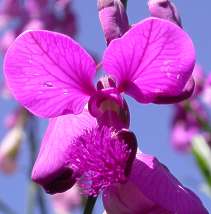Polygala virgata
Polygala virgata Thunb.
Family: Polygalaceae
Common names: Purple Broom (Eng.); Persboom, Bloukappie (Afr.); Ea moru (Nd); Hlokoa leleue (Sotho); Ithethe (Z)
Introduction
This charming slender shrub, bearing spikes of bright purple magenta winged flowers is an eye-catcher in any garden. Polygala virgata is one of the beautiful species belonging to the Polygalaceae family also commonly known as the milkwort family.

Description
Description
Polygala virgata is an erect, evergreen shrub and grows to a height of 1,5 to 2,5 m. A single stem is formed at the base of the plant and slender hairless branches occur at the top. Simple leaves are alternately arranged on younger branches and usually drops before flowering. The leaves are narrow in shape, dark green with a velvety texture and 10 mm in length.

Drooping racemes of deep purple magenta flowers are borne at the ends of branches. The flowers look similar to that of a pea family Fabaceae, but are different. The flower is enclosed by 2 large purple bonnet-like bracts and streaked with darker veins. These open to show that the flower has a purple tuft of tiny hairs at the top of the lower keeled petal. The outer two petals surround the lowest petal like a bonnet.
The purple tuft of hairs is a distinctive characteristic to identify all polygalas. Peak flowering time is from September to February. The fruit is a two-celled capsule and the seed is small, black and oval shaped.
Distribution and habitat
Distribution description
Polygala virgata grows naturally on lower slopes and edges of bushy hillsides and along stream banks. It grows in sandstone, clay or limestone slopes and along forest margins. Protected by other trees and shrubs. It has a wide distribution and occurs both in Tropical and East Africa, southwards through Natal, Transvaal, into the Cape as far as George. Growing in the Drakensberg it is found at an altitude of 250 to 1800 m.
Polygalaceae (milkwort family) is a large family with 17 genera and 950 species found throughout the world in temperate and warm climates. Of 400-450 African species, 32 occur in Cape region. The genus Polygala consists of about 600 species with 232 species in Africa and Madagascar of which approximately 88 species occur in southern Africa.
Derivation of name and historical aspects
History
The genus name Polygala was given by Linnaeus, derived from the Greek polus meaning many or much and gala meaning milk refers to supposed property of European species to increase milk in cows if grazed.
Ecology
Ecology
The shrub is a buzz with bees, insects and bumblebees attracted to the bright purple magenta flowers.

Uses
Use
The leaves and stems were traditionally prepared and used as blood purifiers. The plant is grazed when in reach of stock and game. The beautiful flowering sprays can be used in a vase with a combination of flowers and green fillers.
Growing Polygala virgata
Grow
Polygala virgata is a fast growing, hardy shrub and can be grown in any garden in South Africa. Once established in the garden will tolerate drought, wind and some frost. With its beautiful sprays of flowers it will be an accent plant in a shrubby garden or rockery. Planted in good enriched soil in a sunny or semi-shade position in the garden. It requires water once established to encourage rapid and healthy growth.
The purple broom is self-seeding and small seedlings appear around the parent plant after the first flowering season. These seedlings can be transplanted easily. Individual plants are fairly short-lived, but can be easily replaced with seedlings.
Polygala virgata is easily grown from seed during autumn to spring.
Other well-known garden species are Polygala fruticosa , a compact shrub with pink-purple flowers borne at the tips of branches. It grows to a height of 1,5 - 2m.
Polygala myrtifolia, the September bush is an attractive shrub with masses of purple-pink flowers during spring and summer. It is a hardy shrub and suitable for fynbos and coastal gardens.
References
- Pienaar, K.1985. Grow South African Plants . Struik publishers, Cape Town.
- Pooley, E. 1998. A field guide to wild Flowers Kwazulu-Natal and the Eastern Region . Natal Flora trust, Durban.
- Pearse, R.O. 1978. Mountain Splendour, The Wild flowers of the Drakensberg . Howard Timmins, Cape Town.
- Honson, N.K., Jessop, J.P. and vd R, Grinn, M.C. and Kelly, J. 1975. Veld Plants of South Africa . Macmillan, Johannesburg.
- Joffe, P. 2003. Easy guide to Indigenous Shrubs . Briza Publications, Pretoria.
Credits
Norma Jodamus
Kirstenbosch NBG
December 2004
Plant Attributes:
Plant Type: Shrub
SA Distribution: Eastern Cape, Free State, Gauteng, KwaZulu-Natal, Limpopo, Mpumalanga, North West, Western Cape
Soil type: Sandy, Clay, Loam
Flowering season: Spring, Early Summer, Late Summer
PH: Acid, Alkaline, Neutral
Flower colour: Purple, Pink
Aspect: Full Sun, Morning Sun (Semi Shade), Afternoon Sun (Semi Shade)
Gardening skill: Easy
Special Features:
Horticultural zones











Rate this article
Article well written and informative
Rate this plant
Is this an interesting plant?
Login to add your Comment
Back to topNot registered yet? Click here to register.